Setting Up a Chicken Coop: 8 Essential Features
Inside a Chicken Coop: 8 Essential Features

What makes the inside of a chicken coop a healthy home for your chickens and a place that they’ll love to come back to every night? Here, we’ll explore 8 interior features of a chicken coop to discover why each feature is important and how it contributes to the health and safety of your chickens.
So what should be inside a chicken coop? Let’s take a look at some essential features.
Roosting Perch

One of the most important things to have inside an A-frame chicken coop or any coop is roosts for your chickens. Chickens sleep best in the air, so providing a roost for your chickens inside the coop is very important. In unprotected environments, chickens sleep on roosts to protect themselves from predators.
Although this isn’t necessary for a closed coop, sleeping on a roost keeps chickens off the floor, where they are more susceptible to bacteria and disease. Roosts should be constructed from a material such as wood rather than metal or PVC.
Roosts should be installed higher than the nesting boxes since chickens will usually seek out the highest perch for sleeping. Depending on the height at which you set your roosting perches, you may need to install a chicken coop ramp so your chickens can easily access their resting spot.
A sturdy roost that is large enough to accommodate all the chickens is one of the most important interior features of a chicken coop.
Nesting boxes
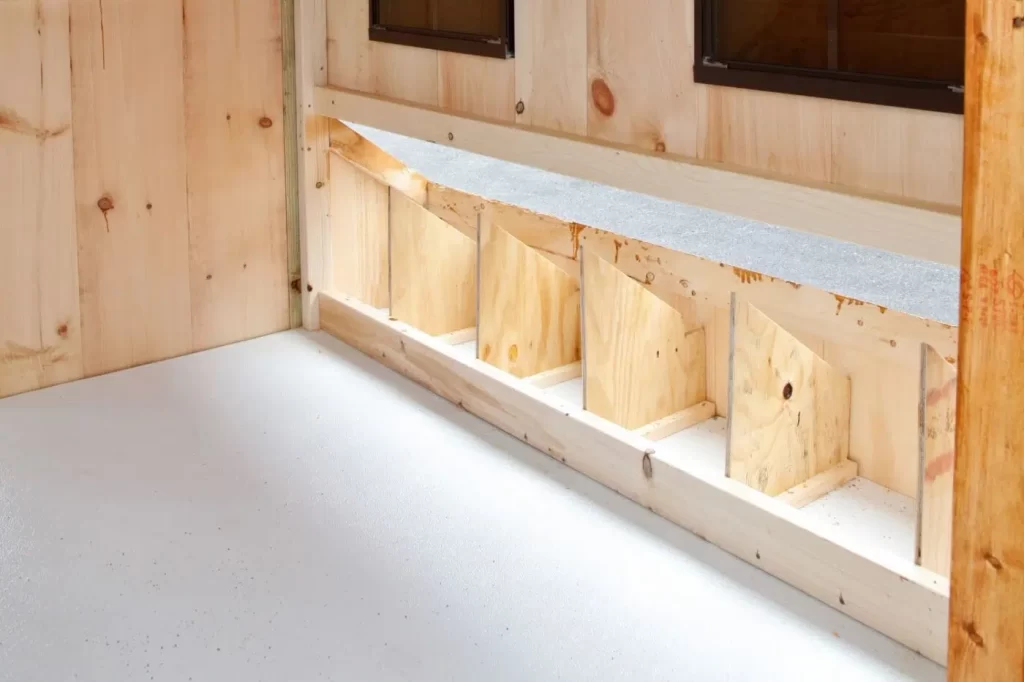
The inside of a chicken coop should always have nesting boxes for your laying hens. Nesting boxes provide a quiet place for your chickens to lay eggs and a convenient place for you to find the eggs in time for breakfast.
The nesting boxes should be kept as dark as possible and installed lower than the roosting bar to prevent chickens from pooping in them. Recommendations for how many boxes should be provided per chicken vary, but a safe guide is 4-5 chickens per box. The boxes can be lined with a dry bedding material such as wood shavings or chopped straw, which should be changed periodically to prevent the buildup of harmful bacteria.
Chickens prefer to nest and lay eggs in soft bedding, but they should not be sleeping or loitering in the boxes for very long. Nesting boxes are provided solely to lay eggs.
Insulation

Although your coop should be well-ventilated, it should not be drafty. Cracks and small openings should be closed to keep snakes, mice, and other rodents from entering. Another important insulation factor to consider is ceiling insulation. Insulation in the ceiling helps to keep the coop cooler during the hot summer months.
If your coop has a metal roof, you’ll want to have insulation installed between the roof metal and framing during the construction of the coop. If your coop has an asphalt shingle roof, be sure to use Tech Shield roof sheathing as a barrier against excessive heat from the sun. Tech Shield sheathing usually provides adequate protection against heat and no additional insulation is needed in the ceiling of your coop.
Lighting
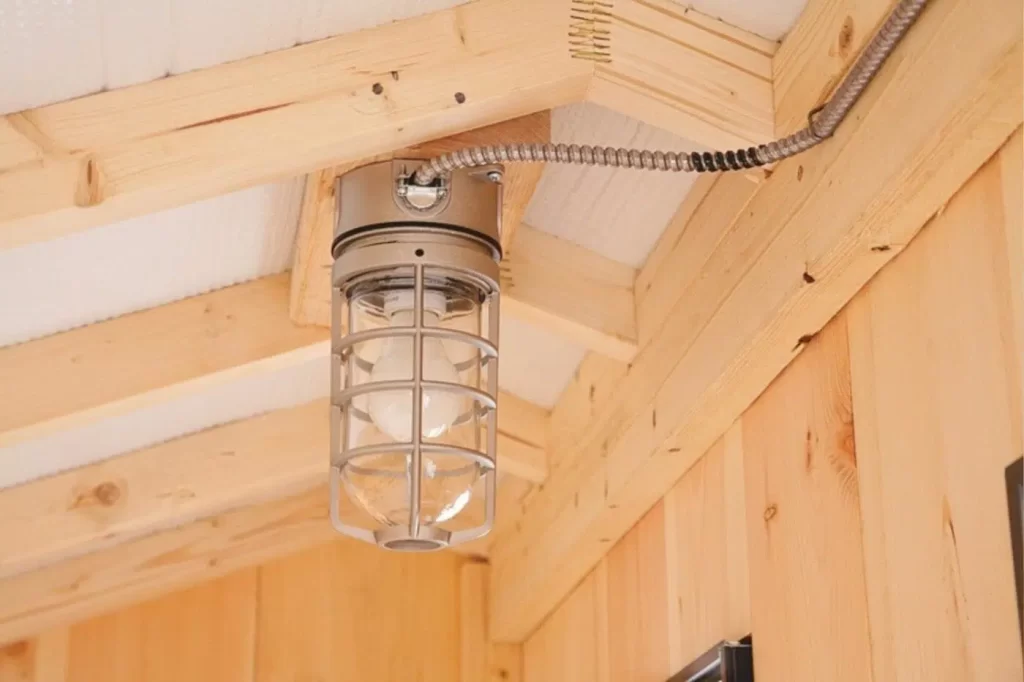
Adequate lighting is important, especially if your chickens will spend a significant amount of time inside the coop. Since a chicken’s reproductive cycles are regulated by natural light, your chickens may stop producing eggs if they lack enough light.
Windows are the best way to let in natural light during the daytime. An artificial, soft, yellow light can be used inside the coop during winter months in the Northern Hemisphere with fewer daylight hours. However, a continuous light inside the coop is not recommended.
Artificial lighting should be used with caution as it can tamper with a chicken’s natural reproductive cycles. (you may be interested in this well-written article on using supplemental lighting to promote egg production)
Air Quality
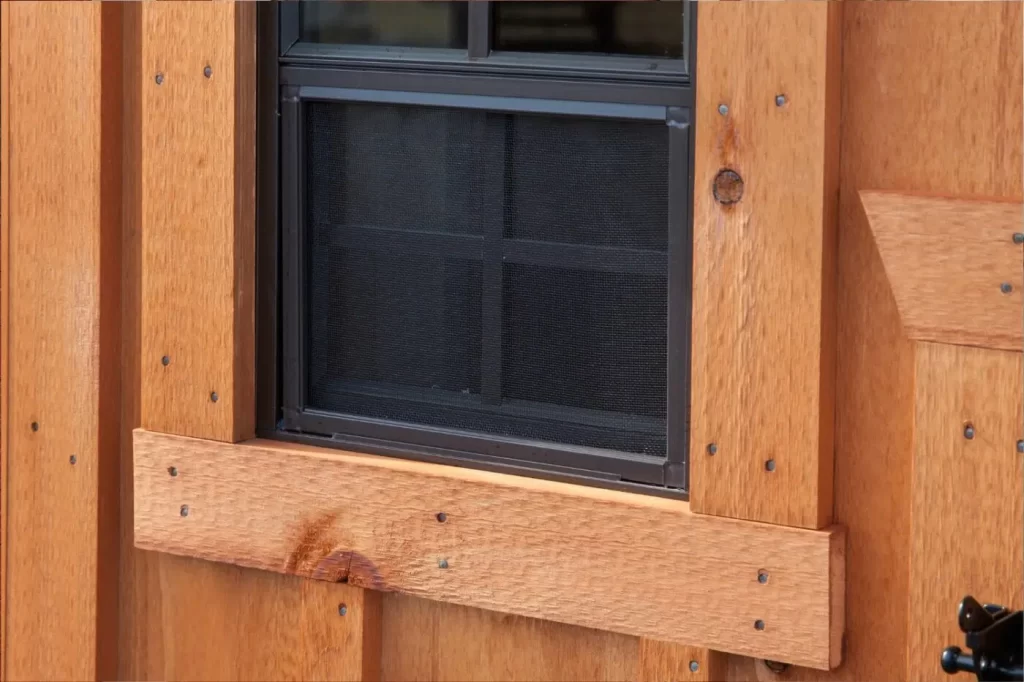
You should pay attention to the air quality in your coop. One of the biggest causes of poor air quality inside a chicken coop is ammonia. Ammonia is released from fresh or moist chicken feces and can be bad for the health of your chickens if it reaches high levels (read this helpful article about ammonia and chickens).
Providing adequate ventilation is a key component to controlling the levels of ammonia in the air inside a barn-style chicken coop. Vents should be positioned to remove contaminated air from the top of the coop without making the coop feel drafty. The best position for vents is usually near the top of the coop.
Litter Trays
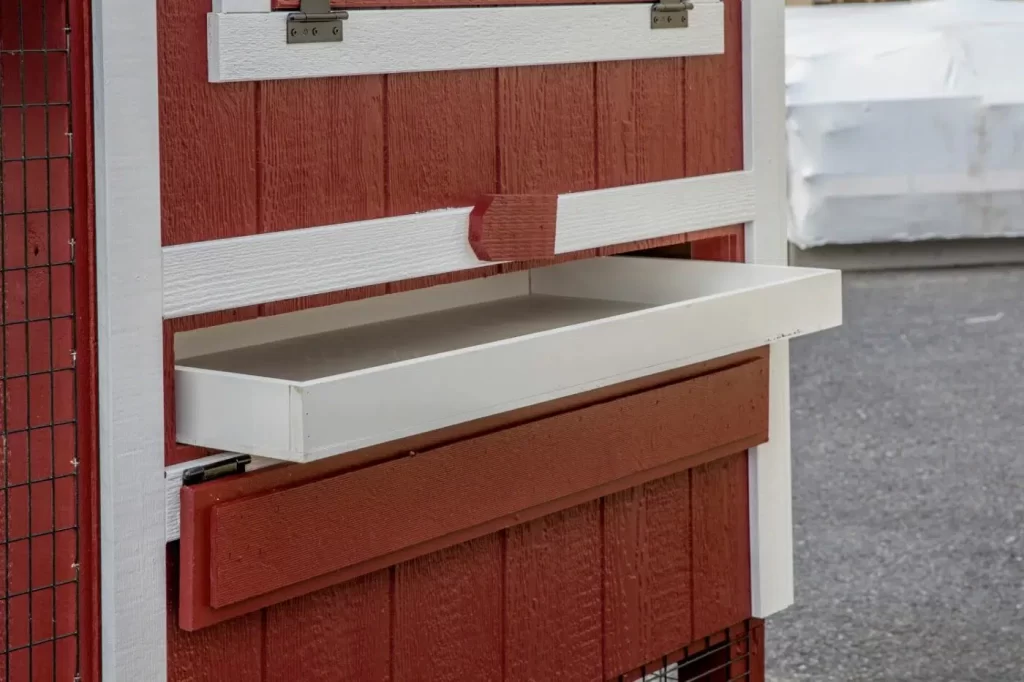
Chickens poop while sleeping, so using a litter tray under the chicken roost is a great way to make cleaning the coop easier. Chicken feces should be removed from the coop frequently to help control ammonia levels (see the section on ventilation).
A litter tray makes frequent removal of the majority of the waste that collects in a coop possible. The litter tray should be cleaned daily, or at least weekly as a bare minimum. Simply pull out the tray, scrape the chicken feces onto your compost pile, and replace it. You’ll be able to complete this step in minutes if you make it a part of your morning egg-gathering routine.
Tip: Line your litter tray with newspaper to make frequent cleaning super easy!
Raised Floor
One of the best materials for a chicken coop floor is plywood. A plywood floor can be raised off the ground to help in keeping the floor and bedding dry. A floor with airflow underneath will shed moisture more quickly than a concrete slab or dirt floor.
A raised plywood floor is also a very tight floor that prevents unwanted predators and rodents from entering. If your chicken coop is a storage shed with a plywood floor on runners, use a tight wire mesh instead of wood to close off the underside of the shed to intruders. A solution like black vinyl-coated wire is better than wood since it allows air to flow under the shed while still closing it off to intruders.
Raising the floor in a prefab chicken coop is an inexpensive way to promote the health and safety of the chickens in a wooden chicken coop.
Tip: A plywood floor should be covered with epoxy or a similar material to make cleaning easier.
Food and Water Supply
Last but not least, a well-functioning feeder and drinkers are some of the most important components of the interior of your coop. The feeder and drinkers should be kept away from the roost to prevent chickens from pooping in them while roosting. They can also be suspended off the ground a few inches so that they don’t collect as much bedding when chickens are scratching nearby.
Feeders and drinkers should be clean, well-stocked, and easily accessible to your chickens at times. Partially dehydrated or under-fed chickens are much more prone to disease and will be less productive.
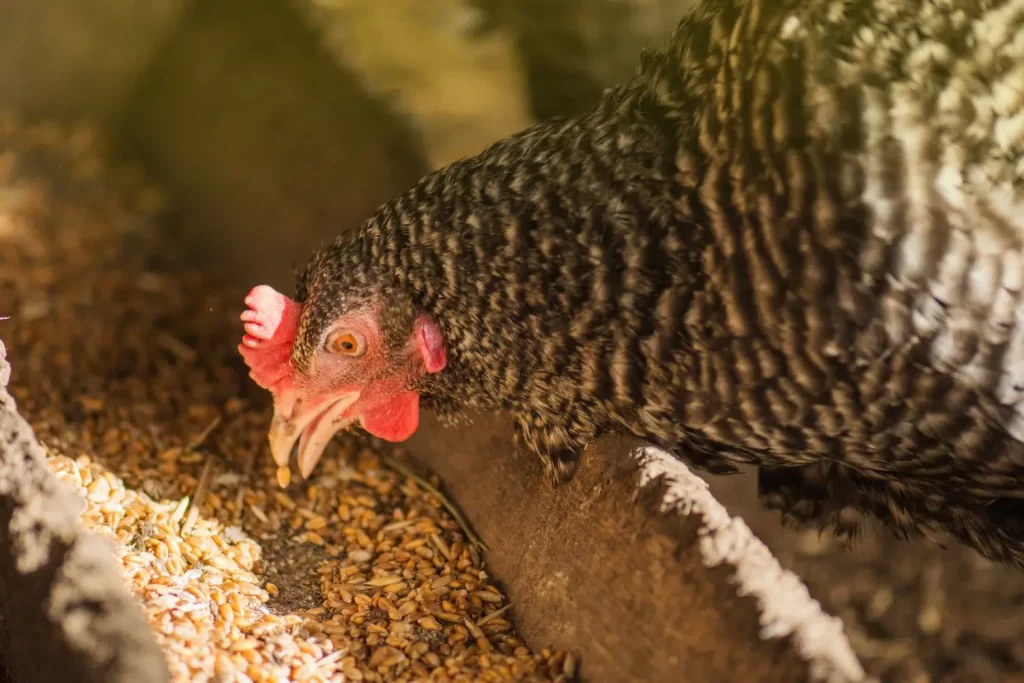
Bonus: Chicken Coop Size
Remember to consider the chicken coop size when planning the interior layout of your coop. An overcrowded chicken coop is detrimental to the health of your flock.
Are You Prepared for Success?
These 8 features should be high on your priority list when thinking about the interior design of your new coop. A chicken coop with a good design will make a significant contribution to the health and well-being of your flock and, in the long run, reduce the cost of raising chickens.
Conversely, keeping chickens in an old shed with a damp, dirt floor and little ventilation may bring with it a greater struggle to keep your flock healthy. A well-designed coop will also be easier to clean.
When shopping for your new coop, pay attention to the interior design and features to make sure you’re well-prepared for your chicken farming venture.
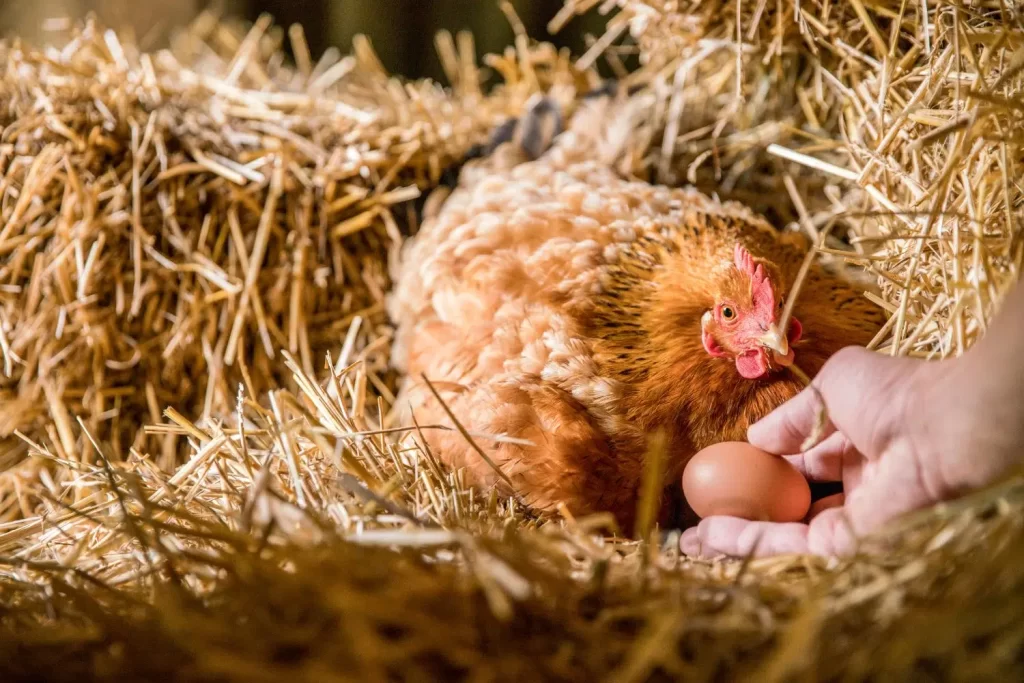
Check out this family’s dream backyard coop and see for yourself how a small chicken coop or a large chicken coop from The Hen House Collection could benefit you! source
Chicken coop floor options: The best flooring materials for your coop
Jan 13, 2022
Choosing the right floor for your chicken coop is very important for your chickens’ health and happiness. The right flooring can also make your life a lot easier, after all, you’re the one who has to build, clean, and maintain it. There are many flooring options for a chicken coop such as concrete, timber boards, plywood, wire mesh or dirt. There are also many options for covering your chicken coop flooring to make it easier to clean or more comfortable for your chickens, we’ll talk about some options below.
Concrete chicken coop flooring
Concrete is the longest lasting and most durable chicken coop flooring option. The hard surface prevents burrowing rodents and other predators from getting into your coop through the floor, it is also easy to clean and very low maintenance. The down side of concrete is that it is expensive and means that your chicken coop will have to stay in the same location with its permanent concrete floor. It can also be very cold, so if you live in a cold climate then you should use a deep bedding on top of it to keep it warmer for your chickens. Concrete is the ideal flooring for chicken owners who want an easy-to-maintain flooring option for their chicken coop in a permanent location.
| Pros | Cons |
| Very durable Easy to clean Very low maintenance Burrowing predators can’t get through it |
Expensive Permanent Hassle to install Cold in winter |
In the picture above you can see on the left side the clean timber board floor and on the right it has been covered with wood chip bedding that absorbs the poop
Timber board chicken coop flooring
Wood is probably the most common material used for chicken coop flooring. It is strong, easy to build and it also provides some insulation for cold environments. Timber flooring is often used in relocatable chicken coops with the flooring set up off the ground a couple of inches. The timber boards give relocatable coops extra strength which helps to prevent the building getting damaged when being moved.
Unfortunately timber boards are a bit more difficult to clean than concrete because of the rough wood grain surface and the cracks in between the boards where dirt can get stuck in. The gaps between the boards are also popular hiding spots for red mites. Wooden chicken coop flooring will not last as long as concrete, especially if you’re in a damp climate. If you’re choosing a wooden flooring we suggest that you cover it with a few coats of paint to make it easier to clean and make sure the timber is at least H3 treated to prevent it rotting. You can also cover it with plastic, rubber or linoleum to make it easier to clean, we’ll talk more about these options below.
| Pros | Cons |
| Affordable Easy to build Good insulation Good option for relocatable coops |
Harder to clean than concrete Gaps between boards hide red mites Won’t last as long as concrete |
Plywood chicken coop flooring
Plywood is a laminated wooden sheet that can easily be cut to fit your chicken coop floor. Like wooden boards it is strong, easy to build/install and provides good insulation for your chicken coop. The added advantage of plywood is it doesn’t have any gaps between boards for red mites hide or dirt to get stuck in. This makes it a bit easier to clean. A thick plywood (at least 12mm) is also harder for rodents or predators to get in through than timber boards just make sure there’s no gaps big enough for small rodents to squeeze through.
Plywood is not quite as strong as timber boards so it’s not usually used for relocatable chicken coops. The plywood used should be H3 treated so that it doesn’t rot and as long as you are using bedding, or a floor covering your plywood flooring will be very easy to clean. You simply remove the droppings with the bedding.
| Pros | Cons |
| Affordable Easy to build Good insulation |
Harder to clean than concrete Won’t last as long as concrete Not as strong as timber boards |
Pictured above is an inside view of an Outpost 3 bay Hen House with no floor. If you are worried about rodents getting into your chicken coop then we recommend you choose a timber floor or lay a concrete pad for your chicken coop flooring.
Dirt chicken coop flooring
You can simply use a dirt floor for you chicken coop, it is the cheapest option and dirt is a natural, soft surface for your chickens feet. Dirt flooring is commonly used for relocatable chicken coops and chicken tractors. If you move your chicken coop regularly to fresh ground your chickens will enjoy scratching in the grass and dirt and their poop will fertilize the ground.
Dirt flooring is not a good option if you have a permanent coop and live in a rainy climate as it will get muddy and messy inside your coop. It also provides no protection from predators who can burrow through dirt to get inside your chicken coop. It is also much harder to keep clean than other flooring options as you can’t just hose it off, you have to scrape off the poop with a spade. We recommend using bedding such as wood shavings or sand if you choose a dirt floor, this will make it much easier to clean as you can just shovel out the bedding and replace it with new clean bedding as required.
| Pros | Cons |
| Cheapest option Soft on chickens feet Good for relocatable coops or chicken tractors |
Harder to clean Easy for rodents and predators to get in Can get wet and muddy |
Wire mesh chicken coop flooring
Some people use wire mesh (sometimes called hardware cloth) flooring in their chicken coops. This is not a common flooring option in New Zealand but is quite common overseas for keeping predators out such as snakes and rodents. Wire mesh flooring can be easy to clean as the chicken poop falls through the mesh and can be caught on a drop sheet below, or can be swept or raked out underneath the floor. It can also used in a relocatable chicken coop so you don’t need to clean out the poop at all as the chicken coop is moved regularly to new ground and away from the mess.
This flooring option is not suitable for cold climates as it lets drafts inside and offers no insulation. You also need to be careful that the wire mesh chosen has small enough holes in it that predators can’t get through them but is strong enough that the predators can’t break the wire to get through. Be aware that chickens can injure themselves on the wire as well. If the wire mesh you choose has small holes (less than 15mm square) then the poop might not fall through, and it’d be hard to clean. If you choose wire mesh with bigger holes then rodents will be able to get through it – a mouse can get through a small 6-7 mm hole and a rat can get through a 20 mm hole.
| Pros | Cons |
| Easy to clean if in the right coop Can help keep predators out Good for relocatable coops or chicken tractors |
May be expensive or sold in large rolls Not suitable for cold climates Chickens can injure themselves on it |
Chicken coop floor liner materials
The most commonly used floor liner materials are paint, linoleum, vinyl, rubber mats or plastic. If you use a thick layer of bedding such as wood shavings or sand then you probably don’t need a floor liner as all the poop gets soaked up into the bedding and the flooring won’t get dirty anyway.
Paint is definitely a good option for timber or wooden flooring. It’ll help protect the wood, make it easier to clean and prevent it from rotting if it is not treated. The paint also fills in some of the hiding spots that red mites like to live in.
Linoleum or vinyl floor coverings are often used as they are easy to clean and reasonably low cost. You do need to be careful what product you choose as some vinyl flooring is toxic and if your chickens peck at it then they can get sick. So, if you do decide to use vinyl, make sure you use a very thick layer of bedding so your chickens can’t consume the poisonous material. The quality of Linoleum and vinyl flooring products varies a lot so it might pay to get a more expensive one that will last a long time instead of having to replace it many times. It is best to staple this type of floor covering down instead of gluing it as some types of glue can be toxic and staples will also make it easier to remove and replace it you ever have to.
Rubber mats are sometimes used as a chicken coop floor covering. They offer great insulation and are easy to clean. There are many types of rubber mats available such as ones used for livestock and horse stable matting. This option is quite expensive and you’ll have to get the rubber mat custom cut to fit your chicken coop exactly.
Invest in a coop that you can move!
Outpost Chicken Coops are relocatable and designed so you can move your hens to fresh ground regularly. They come with or without a timber board floor so you can choose if you want to use a dirt, concrete or timber floor for your chicken coop. There are many circumstances where having an easy to relocate chicken coop is beneficial as well as the ability to use the chicken coop as a chicken tractor! The strong timber framing on an Outpost Chicken Coop is mounted onto heavy duty 4×4″ timber skids so you can tie your tow rope onto it and drag it around your paddock or yard. Whether we plan to stay living in the same place for long term or just short term there is no telling for sure that where you want to position your chicken coop today will be where you want it in years to come. See our blog about Relocatable Chicken Coops for more information >

